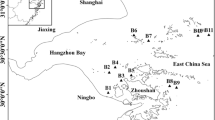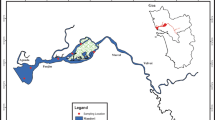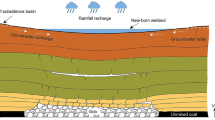Abstract
Hydrological conditions is a driving factor in wetland ecosystems, and excessive changes in hydrological conditions will lead to severe degradation of wetlands. Assessment of ecosystem status is essential for wetland protection and restoration. We analyze the effect of hydrological conditions on food webs from the perspective of eco-exergy. The results showed that the wet environment with low water depth (0~50 cm) is conducive to the growth of aquatic plants. The suitable water depth for benthic and phytoplankton was 40~100 cm, for periphyton, zooplankton and fish was 40~120 cm, 80~120 cm, and 80~100 cm, respectively. With the increase of water depth, the trend of the eco-exergy and specific eco-exergy of plankton was basically the same, while the eco-exergy and specific eco-exergy of other aquatic organisms change in the opposite direction. The results demonstrated that water depth have a significant impact on the structure and function of the food web, the contributors of eco-exergy were producers and consumers within the water depth of 20~60 cm. and the contributors of eco-exergy was the consumers within the water depth of 80~120 cm. The results showed that this approach can serve as a useful tool for assessing ecosystem status by determining ecological water levels.

















Similar content being viewed by others
References
Alexander P, Nielsen DL, Nias D (2008) Response of wetland plant communities to inundation within floodplain landscapes. Ecological Management & Restoration 9:187–195
Banerjee A, Chakrabarty M, Rakshit N, Mukherjee J, Ray S (2017) Indicators and assessment of ecosystem health of Bakreswar reservoir, India: an approach through network analysis. Ecological Indicators 80:163–173
Bellio M, Kingsford RT (2013) Alteration of wetland hydrology in coastal lagoons: implications for shorebird conservation and wetland restoration at a Ramsar site in Sri Lanka. Biological Conservation 167:57–68
Boudewijin B, Willems J, Gusewell S (2007) Flood events overrule fertiliser effects on biomass production and species richness in riverine grasslands. Journal of Vegetation Science 18:625–634
Brower S, Leff L, Mou XZ (2017) Effects of short and long-term hydrological regimes on the composition and function of denitrifying Bacteria in experimental wetlands. Wetlands 37:573–583
Chen WM, Huang XF, Zhou FP (2005) Lake ecosystem observation method, China Environmental Science Press Publication, Beijing, pp 17–37 (In Chinese)
Cui Z (2017) Eco-hydrological regulations based on habitat requirements of Grus leucogeranus: a case study in Baihe Lake, Momoge National Natural Wetland Reserve, Northeast China. University of Chinese Academy of Sciences, Changchun (In Chinese)
Elderd BD, Nott MP (2008) Hydrology, habitat change and population demography: an individual-based model for the endangered cape sable seaside sparrow Ammodramus maritimus mirabilis. Journal of Applied Ecology 45:258–268
Haas K, Kohler U, Diehl S, Köhler P, Dietrich S, Holler S, Jaensch A, Niedermaier M, Vilsmeier J (2007) Influence of fish on habitat choice of water birds: a whole system experiment. Ecology 88:2915–2925
Jiang HX, Liu CY, Sun XW, Lu J, Zou CL, Hou YQ, Lu XG (2015) Remote sensing reversion of water depths and water Management for the Stopover Site of Siberian cranes at Momoge, China. Wetlands 35:369–379
Jørgensen SE (1995) Exergy and ecological buffer capacities as measures of ecosystem health. Ecosystem Health 1:150–160
Jørgensen SE (2006) Application of holistic thermodynamic indicators. Ecological Indicators 6:24–29
Jørgensen SE, Nielsen SN (2007) Application of exergy as thermodynamic indicator in ecology. Energy 32:673–685
Jørgensen SE, Ladegaard N, Debeljak M, Marques JC (2005) Calculations of exergy for organisms. Ecological Modelling 185:165–175
Jørgensen SE, Marques JC, Nielsen SN (2016) Integrated environmental management: a transdisciplinary approach. CRC press. Taylor and Francis Group, Boca Raton, p 369
Joseline M, Fuensanta S, Marcos C, João CM (2013) Hermodynamic oriented ecological indicators: application of eco-exergy and specific eco-exergy in capturing environmental changes between disturbed and non-disturbed tropical reservoirs. Ecological Indicators 24:543–551
Kingsford RT, Thomas R (2004) Destruction of wetlands and waterbird populations by dams and irrigation on the Murrumbidgee River in arid Australia. Journal of Environmental Management 34:383–396
Kingsford RT, Jenkins KM, Porter JL (2004) Imposed hydrological stability on lakes in arid Australia and effects on waterbirds. Ecology 85:2478–2492
Li D, Erickson RA, Tang S, Zhang Y, Niu Z, Liu H, Yu H (2016) Structure and spatial patterns of macrobenthic community in tai Lake, a large shallow lake, China. Ecological Indicators 61:179–187
Linares MS, Callisto M, Marques JC (2017) Invasive bivalves increase benthic communities complexity in neotropical reservoirs. Ecol Indic 75:279–285
Linares MS, Callisto M, Marques JC (2018a) Compliance of secondary production and eco-exergy as indicators of benthic macroinvertebrates assemblages' response to canopy cover conditions in Neotropical headwater streams. Science of the Total Environment 613–614:1543–1550
Linares MS, Callisto M, Marques JC (2018b) Thermodynamic based indicators illustrate how a run-of-river impoundment in neotropical savanna attracts invasive species and alters the benthic macroinvertebrate assemblages’ complexity. Ecological Indicators 88:181–189
Liu QC, Fan YW (2013) Preliminary report on the Phytopankton of Momoge wetland in spring. Natural Sciences Journal of Harbin Normal University 31:128–131 (In Chinese)
Ludovisi A, Poletti A (2003) Use of thermodynamic indices as ecological indicators of the development state of lake ecosystems 2. Exergy and specific exergy indices. Ecological Modelling 159:223–238
Marchi M, Jørgensen SE, Bécares E, Corsi I, Marchettini N, Bastianoni S (2011) Dynamic model of Lake Chozas (León, NW Spain)—decrease in eco-exergy from clear to turbid phase due to introduction of exotic crayfish. Ecological Modelling 222:3002–3010
Marden SL, Marcos C, João CM (2018) Thermodynamic based indicators illustrate how a run-of-river impoundment in neotropical savanna attracts invasive species and alters the benthic macroinvertebrate assemblages’ complexity. Ecological Indicators 88(2018):181–189
Molozzi J, Salas F, Callisto M, Marques JC (2013) Thermodynamic oriented ecological indicators: application of eco-exergy and specific eco-exergy in capturing environmental changes between disturbed and non-disturbed tropical reservoirs. Ecological Indicators 24:543–551
Pan XL, Zhang DY, Quan L (2006) Interactive factors leading to dying-off Carex tato in Momoge wetland polluted by crude oil, Western Jilin, China. Chemosphere 65:1772–1777
Patrício J, Neto JM, Teixeira H, Salas F, Marques JC (2009) The robustness of ecological indicators to detect long-term changes in the macrobenthos of estuarine systems. Marine Environmental Research 68:25–36
Robson BJ, Lester RE, Baldwin DS, Bond NR, Drouart R, Rolls RJ, Ryder DS, Thompson RM (2017) Modelling food-web mediated effects of hydrological variability and environmental flows. Water Research 124:108–128
Royan A, Hannah DM, Reynolds SJ, Noble DG, Sadler JP (2014) River birds’ response to hydrological extremes: new vulnerability index and conservation implications. Biological Conservation 177:64–73
Salas F, Marcos C, Pérez-Ruzafa A, Marques JC (2005) Application of the exergy index as ecological indicator of organically enrichment areas in the Mar Menor lagoon (south-eastern Spain). Energy 30(13):2505–2522
Sheldon F, Walker KF (1997) Changes in biofilms induced by flow regulation could explain extinctions of aquatic snails in the lower river Murray, Australia. Hydrobiologia 347:97–108
Silow EA, In-Hye O (2004) Aquatic ecosystem assessment using exergy. Ecological Indicators 4:189–198
Silow EA, Mokry AV (2010) Exergy as a tool for ecosystem health assessment. Entropy 12:902–925
Tang D, Zou X, Liu X, Liu P, Zhamangulova N, Xu X, Zhao Y (2015) Integrated ecosystem health assessment based on eco-exergy theory: A case study of the Jiangsu coastal area. Ecological Indicators 48:107–119
Tang DH, Liu XJ, Zou XQ (2018) An improved method for integrated ecosystem health assessments based on the structure and function of coastal ecosystems: a case study of the Jiangsu coastal area, China. Ecological Indicators 84:82–95
Timmermans STA, Badzinski SS, Ingram JW (2008) Associations between breeding marsh bird abundances and Great Lakes hydrology. Journal of Great Lakes Research 34:351–364
Tlili A, Dorigo U, Montuelle B, Margoum C, Carluer N, Gouy V, Bouchez A, Berard A (2008) Responses of chronically contaminated biofilms to short pulses of diuron: an experimental study simulating flooding events in a small river. Aquatic Toxicology 87:252–263
Veríssimo H, Verdelhos T, Baeta A, Linden P, Garcia AC, Marques JC (2017) Comparison of thermodynamic-oriented indicators and trait-based indices ability to track environmental changes: response of benthic macroinvertebrates to management in a temperate estuary. Ecological Indicators 73:809–824
Wang Y, Jia Y, Guan L, Lu C, Lei G, Wen L, Liu G (2013) Optimising hydrological conditions to sustain wintering waterbird populations in Poyang Lake National Natural Reserve: implications for dam operation. Freshwater Biology 56:2366–2379
Xu F, Yang ZF, Chen B, Zhao YW (2013) Development of a structurally dynamic model for ecosystem health prognosis of Baiyangdian Lake, China. Ecological Indicators 29:398–410
Xu Z, Yang ZF, Yin XA, Cai YP, Sun T (2016) Hydrological management for improving nutrient assimilative capacity in plant-dominated wetlands: a modelling approach. Journal of Environmental Management 177:84–92
Yang W, Yang ZF (2014) Integrating ecosystem-service tradeoffs into environmental flowsdecisions for Baiyangdian wetland. Ecological Engineering 71:539–550
Yang Y, Chen H, Yang ZF (2012) Integration of water quantity and quality in environmental flow assessment in wetlands. Procedia Environmental Science 13:1535–1552
Yang Y, Yin XA, Yang ZF (2016) Environmental flow management strategies based on the integration of water quantity and quality, a case study of the Baiyangdian wetland, China. Ecological Engineering 96:150–161
Yuan SB, Yang ZD, Liu XQ, Wang HZ (2017) Key parameters of water level fluctuations determining the distribution of Carex in Shallow Lakes. Wetlands 37:1005–1014
Yue JS, Yuan XZ, Li B, Ren HQ, Wang XF (2016) Emergy and exergy evaluation of a dike-pond project in the drawdown zone (DDZ) of the three gorges reservoir (TGR). Ecological Indicators 71:248–257
Zhai SJ, Hu WP, Zhu ZC (2010) Ecological impacts of water transfers on Lake Taihu from the Yangtze River, China. Ecological Engineering 36:406–420
Acknowledgements
This study was supported by Research and Development of Ecological Water supplement and EcoHydrological Regulation Technology of Degraded Wetland (2016YFC0500402) and The Interdiscipline Research Funds of Beijing Normal University. We acknowledge Professor Xianguo Lv from Northeast Institute of Geography and Agricultural Ecology, Chinese Academy of Sciences. We are indebted to all the people who helped with the sampling.
Author information
Authors and Affiliations
Corresponding author
Electronic supplementary material
ESM 1
(DOC 5453 kb)
Rights and permissions
About this article
Cite this article
Bao, K., Liu, J., Meng, B. et al. The Effects of Hydrological Conditions on Eco-Exergy of Food Webs in Momoge National Nature Reserve, China. Wetlands 39, 601–617 (2019). https://doi.org/10.1007/s13157-018-1111-9
Received:
Accepted:
Published:
Issue Date:
DOI: https://doi.org/10.1007/s13157-018-1111-9




